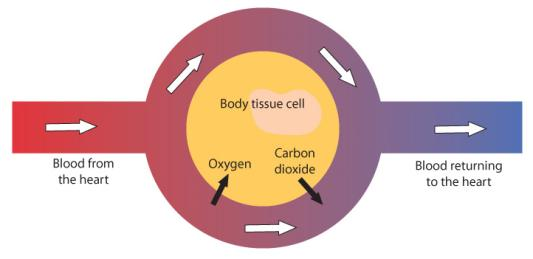
Explain with a schematic representation the exchange of gases in tissues.
Answer
500.1k+ views
Hint: The body uses oxygen to oxidize food that we intake to produce carbon dioxide, water, and energy. This reaction is called a combustion reaction. The necessary oxygen is obtained by breathing air into the lungs, where it is absorbed into the blood and then pumped around the body through the heart. Gases can also be absorbed through the skin and mucous membranes. Methane and nitrogen are the other gases produced in the body.
Complete Explanation:
During the inhalation process the air is taken into the lungs via nasal cavity, passing through the trachea, bronchi, bronchioles and finally alveoli. The air reaching the alveoli is rich in oxygen. Similarly, the blood from the heart that reaches the alveoli is rich in carbon dioxide.
From the alveoli the oxygen diffuses into the red blood cells in the capillaries. Likewise, the red blood cells in the capillaries release carbon dioxide which diffuses into the alveoli.
The red blood cells contain a special red pigment called the Haemoglobin. Haemoglobin combines with oxygen molecules to form oxyhaemoglobin. This oxyhaemoglobin is transported from the lung to the heart.
The oxygen concentration is higher in the capillaries than in the body cells and so the oxyhaemoglobin releases oxygen which diffuses into the body cells. Similarly, the body cells have higher concentration of carbon dioxide than in the capillaries. The carbon dioxide diffuses into the blood capillaries and the blood carries the carbon dioxide back to the heart.
The carbon dioxide is then passed from the heart to the lungs. From there it expires out during the exhalation process. The schematic diagram of gas exchange in the tissues is given below.

Exchange of gases in the body tissues
Note:
The amounts of oxygen consumed by cells and carbon dioxide produced are not always identical to each other. The balance depends on which nutrients are being used for energy. The ratio of carbon dioxide produced and oxygen consumed is known as the respiratory quotient. It is measured by using the respirometer.
Complete Explanation:
During the inhalation process the air is taken into the lungs via nasal cavity, passing through the trachea, bronchi, bronchioles and finally alveoli. The air reaching the alveoli is rich in oxygen. Similarly, the blood from the heart that reaches the alveoli is rich in carbon dioxide.
From the alveoli the oxygen diffuses into the red blood cells in the capillaries. Likewise, the red blood cells in the capillaries release carbon dioxide which diffuses into the alveoli.
The red blood cells contain a special red pigment called the Haemoglobin. Haemoglobin combines with oxygen molecules to form oxyhaemoglobin. This oxyhaemoglobin is transported from the lung to the heart.
The oxygen concentration is higher in the capillaries than in the body cells and so the oxyhaemoglobin releases oxygen which diffuses into the body cells. Similarly, the body cells have higher concentration of carbon dioxide than in the capillaries. The carbon dioxide diffuses into the blood capillaries and the blood carries the carbon dioxide back to the heart.
The carbon dioxide is then passed from the heart to the lungs. From there it expires out during the exhalation process. The schematic diagram of gas exchange in the tissues is given below.

Exchange of gases in the body tissues
Note:
The amounts of oxygen consumed by cells and carbon dioxide produced are not always identical to each other. The balance depends on which nutrients are being used for energy. The ratio of carbon dioxide produced and oxygen consumed is known as the respiratory quotient. It is measured by using the respirometer.
Recently Updated Pages
Master Class 11 Economics: Engaging Questions & Answers for Success

Master Class 11 English: Engaging Questions & Answers for Success

Master Class 11 Social Science: Engaging Questions & Answers for Success

Master Class 11 Biology: Engaging Questions & Answers for Success

Class 11 Question and Answer - Your Ultimate Solutions Guide

Master Class 11 Business Studies: Engaging Questions & Answers for Success

Trending doubts
10 examples of friction in our daily life

One Metric ton is equal to kg A 10000 B 1000 C 100 class 11 physics CBSE

Difference Between Prokaryotic Cells and Eukaryotic Cells

1 Quintal is equal to a 110 kg b 10 kg c 100kg d 1000 class 11 physics CBSE

Explain zero factorial class 11 maths CBSE

What is a periderm How does periderm formation take class 11 biology CBSE




